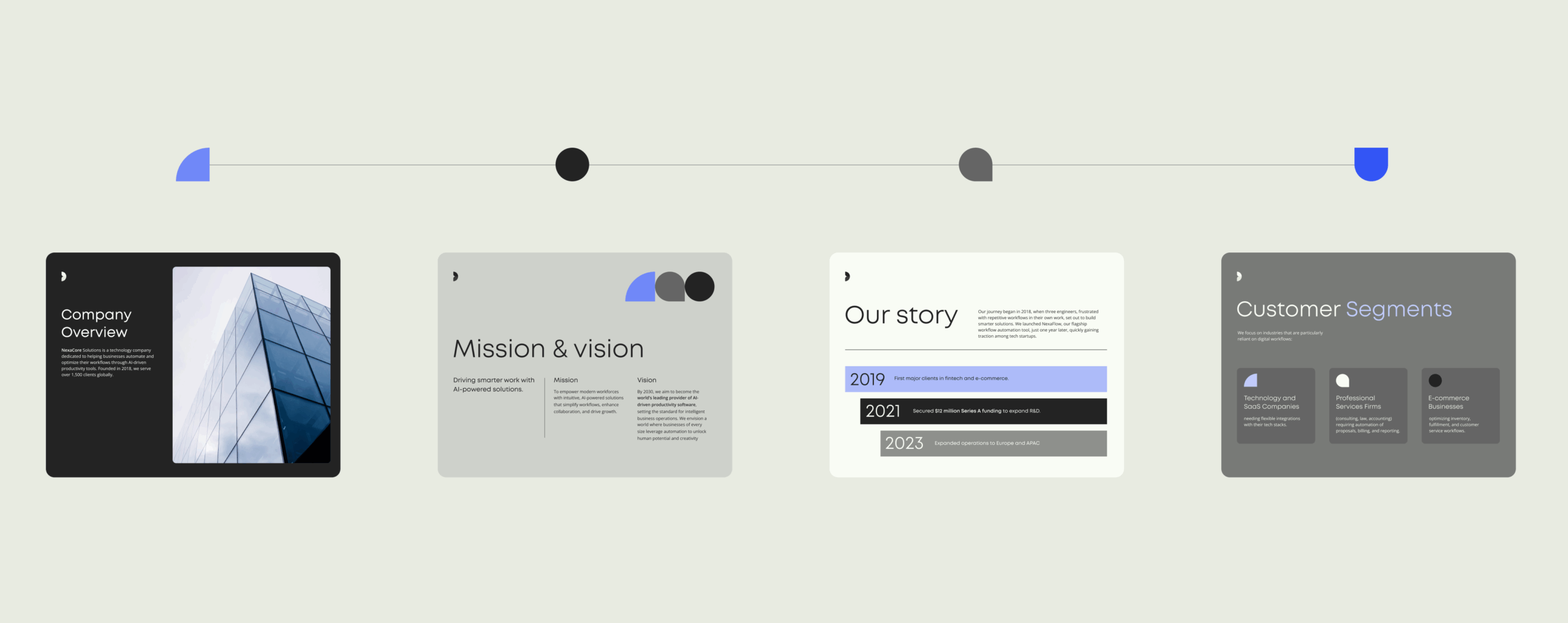The ultimate guide to document assembly

Start automating repetitive tasks and generating error-free documents in minutes with document assembly software.
The advent of the assembly line was a defining piece of the industrial revolution. By streamlining work processes, complex products could be manufactured faster and with far less labor.
Now, more than two hundred years later, document assembly is similarly defining the automation revolution. Gone are the days of piecing together individual reports, presentations, contracts, or other documents from scratch. Document preparation software automates all the repetitive work behind creating business documents — and gives back the time spent on that manual labor.
Read on to learn more about what automated document assembly is, how the technology behind it works, and how it can be used in different industries to significantly improve productivity.
What is document assembly?
Document assembly is the process of automatically generating a digital document based on conditional values and dynamic templates.
Working with document assembly is kind of like building with Legos. A Lego kit might come with a set of instructions, but the finished product will differ depending on which individual bricks are selected.
This technology is a cornerstone in the field of document management, driving efficiency and reliability in document creation. By automating repetitive tasks, it minimizes the risk of human error, ensures consistency across documents, and enables quicker turnaround times.
The process of document assembly involves several key components:
Templates: These are the core of the document assembly workflow. Templates are pre-designed and can contain both fixed content (logos, standard language, etc.) and placeholders for variable content. The fixed content remains the same across all documents generated from the template, while the placeholders (variables) are filled with data specific to each individual document.
Variables: Variables are placeholders within the template that get replaced with actual data during the document creation process. These can include names, dates, figures, images, and any other specific information relevant to the particular document being created. The source of this data might be manual input from a user or automated input from an integrated database or application.
Rules and logic: Many document assembly systems also incorporate rules and logic to handle conditional text (text that appears only under certain conditions), calculations, and formatting changes based on the data input. This allows for greater customization in documents without sacrificing efficiency.
User input: In situations where data needs to be input manually, the document assembly tools will display a user interface that prompts the user to input all necessary information, which is then automatically placed into the appropriate fields within the document.
The Content is Everything report
2,000+ professionals on how rapid content growth is creating new risks
Why use a software to help prepare documents?
Using a dedicated document assembly tool can significantly decrease the amount of time employees spend building documents, searching for content, and reviewing materials.
According to one survey of over 2,000 full-time employees, 78% agreed that good content is the most significant driver of business success. And yet they identified a number of challenges in the document creation process:
- 31% said they don’t know where to find company-approved templates and content
- 62% said their team wastes time recreating content that likely already exists somewhere in their organization.
- 60% said that their company’s processes for approving content delays other work
- 94% said that they still see errors in content, even after it has already been reviewed and approved
No wonder more than half of the survey respondents said that their colleagues constantly complain about the document creation process.
One of the problems suggested by the survey was a technology gap. Over half of the respondents reported that their companies under prioritized their investment in good content tools, leading to insufficient and siloed tech solutions.
Document assembly tools solve these problems by streamlining the entire document creation process on an enterprise level. For example, one leading consultancy saw a 92% reduction in time spent creating new proposals, while achieving greater accuracy.
Who can benefit from document assembly?
Different industries — especially those that deal with high volumes of document creation — can use document assembly to improve accuracy and consistency in their document output.
Legal
Law firms are known for the repetitive creation of documents such as contracts, memos, and other legal forms. Document assembly helps by automating the creation of these documents, ensuring that they are error-free and consistent with current laws and regulations. It also allows legal professionals to customize documents quickly based on specific case details, significantly saving time and reducing the likelihood of manual errors.
Finance
Financial institutions, including banks and accounting firms, use document assembly for generating loan agreements, audit reports, financial statements, and other documents. The technology ensures that numerical data is accurately reflected across all documents and helps in maintaining consistency in client communications, which is critical for regulatory compliance and customer satisfaction.
Human Resources (HR)
HR departments benefit from document assembly in managing employee-related paperwork such as contracts, onboarding materials, and company policies. Automating these processes reduces the time HR professionals spend on paperwork, allows for quick updates to documents when policies change, and improves overall workflow efficiency.
Real Estate
In real estate, document assembly is used for lease agreements, purchase contracts, and other property-related documents. It simplifies the customization of documents according to different state laws or property specifics, which is a frequent requirement in real estate transactions.
Healthcare
Healthcare providers use document assembly for patient forms, consent documents, and regulatory compliance paperwork. Automation helps in ensuring that patient information is handled confidentially and integrated seamlessly across various forms, reducing administrative burdens and allowing healthcare professionals to focus more on patient care.
Public sector
Government agencies utilize document assembly for public service applications, licensing, permits, and compliance documentation. Automating these documents improves service delivery by speeding up processing times and reducing errors.
Templafy’s AI Assistant
Unlock the power of AI without the risks
Getting started with document assembly and automation
Introducing document assembly into your organization and workflows starts with choosing the right technology. Popular document assembly tools include Docassemble, HotDocs, Conga Composer, and Templafy, which each offer unique features tailored to different company sizes, workflows, industries, and requirements.
To choose the right document assembly tool for you, consider the following criteria:
- Available integrations: Look at all the available built-in integrations and APIs to connect with your existing systems, such as CRM platforms, databases, and content creation tools
- Customization: Look for tools that offer extensive customization options and user access levels to meet your specific document workflows
- Usability: Look for software that is user-friendly and doesn’t require extensive technical knowledge to operate.
- Support: Consider the level of customer support provided and whether the tool is regularly updated with new features and improvements
Before making a purchase decision, it’s also a good idea to test out different tools through demos or free trials. Reading reviews can also provide insights into user experiences and potential challenges with the software.
Try Templafy’s leading document preparation solution
Document assembly significantly enhances productivity by automating repetitive tasks, reducing errors, and improving efficiency. These tools ensure high-quality, consistent document outputs which are crucial for compliance and both customer and employee satisfaction.
Templafy’s document generation platform supplements its document assembly tool with additional features like Generative AI, content distribution, email signature management, and more. Learn more about the full range of services and book a demo to see how document assembly can help streamline your workflows and improve efficiency.



